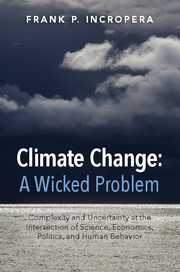 Climate Change: A Wicked Problem
Climate Change: A Wicked Problem Published online by Cambridge University Press: 05 October 2015
If anthropogenic global warming is acknowledged and related threats are taken seriously, what can be done about it? In broad terms, there are three paths that can be taken. The first two are by no means mutually exclusive and, in fact, should be pursued concurrently. One path involves mitigation measures. What can be done to reduce GHG emissions and stabilize atmospheric concentrations at levels of low risk? Globally, can CO2 emissions be reduced to 20% of current levels by 2050 and atmospheric CO2 stabilized at 450 ppm? And what if mitigation measures are insufficient to reduce atmospheric GHG concentrations to acceptable levels, a scenario that is becoming ever more likely?
The second path involves adaptation. Recognizing diminishing prospects for stabilizing GHG concentrations at acceptably low levels, what can be done to increase the resilience of human and natural systems to the effects of climate change? In this chapter we'll examine a range of mitigation and adaptation options. But should mitigation and adaptation measures both fall short of desired outcomes, what then? The chapter concludes with a discussion of measures falling under the rubric of geoengineering – a term used to characterize large-scale engineering endeavors designed to counteract the warming effects of GHG emissions.
We'll begin with mitigation. As shown in Figure 6.1, options for reducing GHG emissions fall into three categories. One category deals with increasing the efficiency of producing and using energy; the second deals with transitioning the world's energy portfolio from carbon-rich to carbon-free sources of energy; and the third deals with collecting and sequestering GHG gases before they are released to the atmosphere. In each case, the scale of implementation needed to achieve meaningful reductions is enormous, requiring large capital investments and global cooperation.
To save this book to your Kindle, first ensure no-reply@cambridge.org is added to your Approved Personal Document E-mail List under your Personal Document Settings on the Manage Your Content and Devices page of your Amazon account. Then enter the ‘name’ part of your Kindle email address below. Find out more about saving to your Kindle.
Note you can select to save to either the @free.kindle.com or @kindle.com variations. ‘@free.kindle.com’ emails are free but can only be saved to your device when it is connected to wi-fi. ‘@kindle.com’ emails can be delivered even when you are not connected to wi-fi, but note that service fees apply.
Find out more about the Kindle Personal Document Service.
To save content items to your account, please confirm that you agree to abide by our usage policies. If this is the first time you use this feature, you will be asked to authorise Cambridge Core to connect with your account. Find out more about saving content to Dropbox.
To save content items to your account, please confirm that you agree to abide by our usage policies. If this is the first time you use this feature, you will be asked to authorise Cambridge Core to connect with your account. Find out more about saving content to Google Drive.